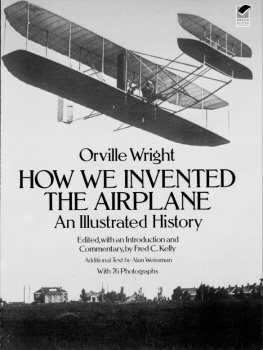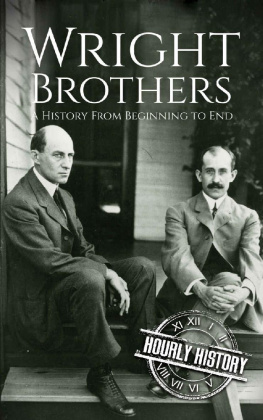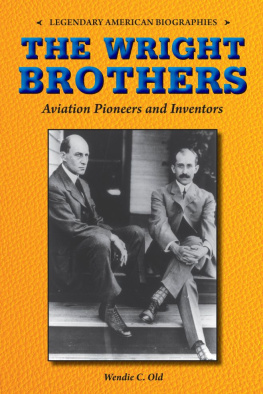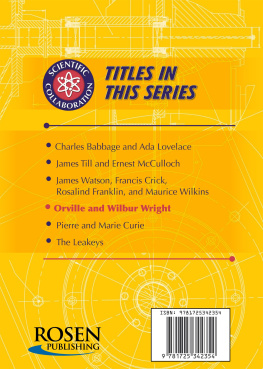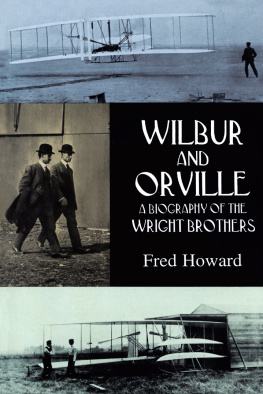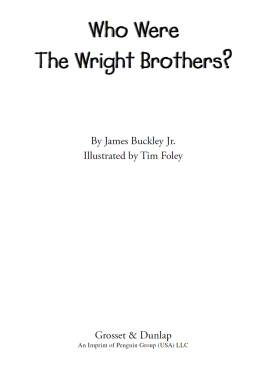Orville Wright - How We Invented the Airplane: An Illustrated History
Here you can read online Orville Wright - How We Invented the Airplane: An Illustrated History full text of the book (entire story) in english for free. Download pdf and epub, get meaning, cover and reviews about this ebook. genre: Non-fiction. Description of the work, (preface) as well as reviews are available. Best literature library LitArk.com created for fans of good reading and offers a wide selection of genres:
Romance novel
Science fiction
Adventure
Detective
Science
History
Home and family
Prose
Art
Politics
Computer
Non-fiction
Religion
Business
Children
Humor
Choose a favorite category and find really read worthwhile books. Enjoy immersion in the world of imagination, feel the emotions of the characters or learn something new for yourself, make an fascinating discovery.
- Book:How We Invented the Airplane: An Illustrated History
- Author:
- Genre:
- Rating:5 / 5
- Favourites:Add to favourites
- Your mark:
- 100
- 1
- 2
- 3
- 4
- 5
How We Invented the Airplane: An Illustrated History: summary, description and annotation
We offer to read an annotation, description, summary or preface (depends on what the author of the book "How We Invented the Airplane: An Illustrated History" wrote himself). If you haven't found the necessary information about the book — write in the comments, we will try to find it.
How We Invented the Airplane: An Illustrated History — read online for free the complete book (whole text) full work
Below is the text of the book, divided by pages. System saving the place of the last page read, allows you to conveniently read the book "How We Invented the Airplane: An Illustrated History" online for free, without having to search again every time where you left off. Put a bookmark, and you can go to the page where you finished reading at any time.
Font size:
Interval:
Bookmark:
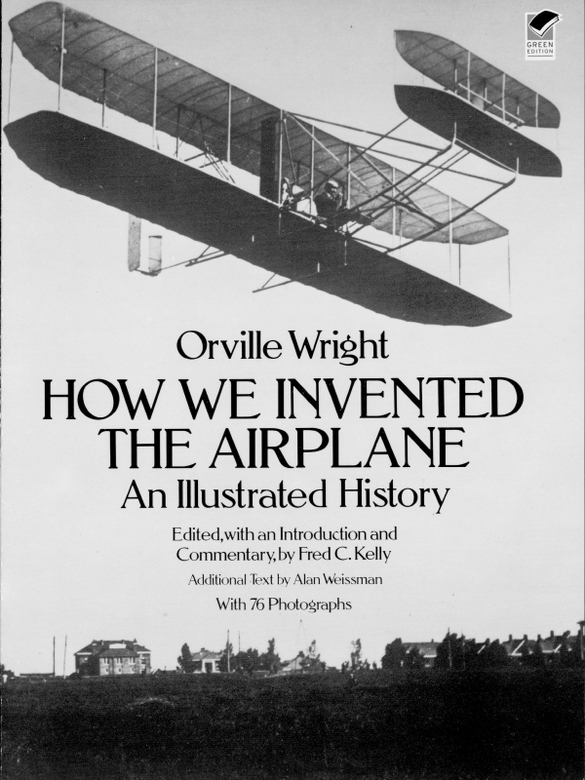
The publisher gratefully acknowledges the cooperation of Dr. Patrick B. Nolan, Archives and Special Collections, Wright State University, in securing most of the photographs printed in this book. Thanks also to Katherine Bourbeau, photo researcher.
Acknowledgments
[by FRED C. KELLY]
The author of this compilation is much indebted to the aeronautics section of the Library of Congress for help, especially to Marvin W. McFarland, who gave many valuable suggestions. He also received shrewd editorial guidance from Frederick Lewis Allen, editor of Harpers Magazine.
by ORVILLE AND WILBUR WRIGHT
THE article which follows is the first popular account of their experiments prepared by the inventors. Their accounts heretofore have been brief statements of bare accomplishments, without explanation of the manner in which results were attained. The article will be found of special interest, in view of the fact that they have contracted to deliver to the United States Government a complete machine, the trials of which are expected to take place about the time of the appearance of this number of THE CENTURY.THE EDITOR [OF THE CENTURY].
T HOUGH THE SUBJECT of aerial navigation is generally considered new, it has occupied the minds of men more or less from the earliest ages. Our personal interest in it dates from our childhood days. Late in the autumn of 1878, our father came into the house one evening with some object partly concealed in his hands, and before we could see what it was, he tossed it into the air. Instead of falling to the floor, as we expected, it flew across the room till it struck the ceiling, where it fluttered awhile, and finally sank to the floor. It was a little toy, known to scientists as a hlicoptre, but which we, with sublime disregard for science, at once dubbed a bat. It was a light frame of cork and bamboo, covered with paper, which formed two screws, driven in opposite directions by rubber bands under torsion. A toy so delicate lasted only a short time in the hands of small boys, but its memory was abiding.
Several years later we began building these hli-coptres for ourselves, making each one larger than that preceding. But, to our astonishment, we found that the larger the bat, the less it flew. We did not know that a machine having only twice the linear dimensions of another would require eight times the power. We finally became discouraged, and returned to kite-flying, a sport to which we had devoted so much attention that we were regarded as experts. But as we became older, we had to give up this fascinating sport as unbecoming to boys of our ages.
It was not till the news of the sad death of Lilienthal reached America in the summer of 1896 that we again gave more than passing attention to the subject of flying. We then studied with great interest Chanutes Progress in Flying Machines, Langleys Experiments in Arody-namics, the Aronautical Annuals of 1905, 1906, and 1907, and several pamphlets published by the Smithsonian Institution, especially articles by Lilienthal and extracts from Mouillards Empire of the Air. The larger works gave us a good understanding of the nature of the flying problem, and the difficulties in past attempts to solve it, while Mouillard and Lilienthal, the great missionaries of the flying cause, infected us with their own unquenchable enthusiasm, and transformed idle curiosity into the active zeal of workers.
In the field of aviation there were two schools. The first, represented by such men as Professor Langley and Sir Hiram Maxim, gave chief attention to power flight; the second, represented by Lilienthal, Mouillard, and Chanute, to soaring flight. Our sympathies were with the latter school, partly from impatience at the wasteful extravagance of mounting delicate and costly machinery on wings which no one knew how to manage, and partly, no doubt, from the extraordinary charm and enthusiasm with which the apostles of soaring flight set forth the beauties of sailing through the air on fixed wings, deriving the motive power from the wind itself.
The balancing of a flyer may seem, at first thought, to be a very simple matter, yet almost every experimenter had found in this the one point which he could not satisfactorily master. Many different methods were tried. Some experimenters placed the center of gravity far below the wings, in the belief that the weight would naturally seek to remain at the lowest point. It was true, that, like the pendulum, it tended to seek the lowest point; but also, like the pendulum, it tended to oscillate in a manner destructive of all stability. A more satisfactory system, especially for lateral balance, was that of arranging the wings in the shape of a broad V, to form a dihedral angle, with the center low and the wingtips elevated. In theory this was an automatic system, but in practice it had two serious defects: first, it tended to keep the machine oscillating; and, second, its usefulness was restricted to calm air.
In a slightly modified form the same system was applied to the fore-and-aft balance. The main aeroplane was set at a positive angle, and a horizontal tail at a negative angle, while the center of gravity was placed far forward. As in the case of lateral control, there was a tendency to constant undulation, and the very forces which caused a restoration of balance in calms, caused a disturbance of the balance in winds. Notwithstanding the known limitations of this principle, it had been embodied in almost every prominent flying-machine which had been built.
After considering the practical effect of the dihedral principle, we reached the conclusion that a flyer founded upon it might be of interest from a scientific point of view, but could be of no value in a practical way. We therefore resolved to try a fundamentally different principle. We would arrange the machine so that it would not tend to right itself. We would make it as inert as possible to the effects of change of direction or speed, and thus reduce the effects of wind-gusts to a minimum. We would do this in the fore-and-aft stability by giving the aeroplanes a peculiar shape; and in the lateral balance, by arching the surfaces from tip to tip, just the reverse of what our predecessors had done. Then by some suitable contrivance, actuated by the operator, forces should be brought into play to regulate the balance.
Lilienthal and Chanute had guided and balanced their machines by shifting the weight of the operators body. But this method seemed to us incapable of expansion to meet large conditions, because the weight to be moved and the distance of possible motion were limited, while the disturbing forces steadily increased, both with wing area and with wind velocity. In order to meet the needs of large machines, we wished to employ some system whereby the operator could vary at will the inclination of different parts of the wings, and thus obtain from the wind forces to restore the balance which the wind itself had disturbed. This could easily be done by using wings capable of being warped, and by supplementary adjustable surfaces in the shape of rudders. As the forces obtainable for control would necessarily increase in the same ratio as the disturbing forces, the method seemed capable of expansion to an almost unlimited extent. A happy device was discovered whereby the apparently rigid system of superposed surfaces, invented by Wenham, and improved by Stringfellow and Chanute, could be warped in a most unexpected way, so that the aeroplanes could be presented on the right and left sides at different angles to the wind. This, with an adjustable, horizontal front rudder, formed the main feature of our first glider.
Font size:
Interval:
Bookmark:
Similar books «How We Invented the Airplane: An Illustrated History»
Look at similar books to How We Invented the Airplane: An Illustrated History. We have selected literature similar in name and meaning in the hope of providing readers with more options to find new, interesting, not yet read works.
Discussion, reviews of the book How We Invented the Airplane: An Illustrated History and just readers' own opinions. Leave your comments, write what you think about the work, its meaning or the main characters. Specify what exactly you liked and what you didn't like, and why you think so.

